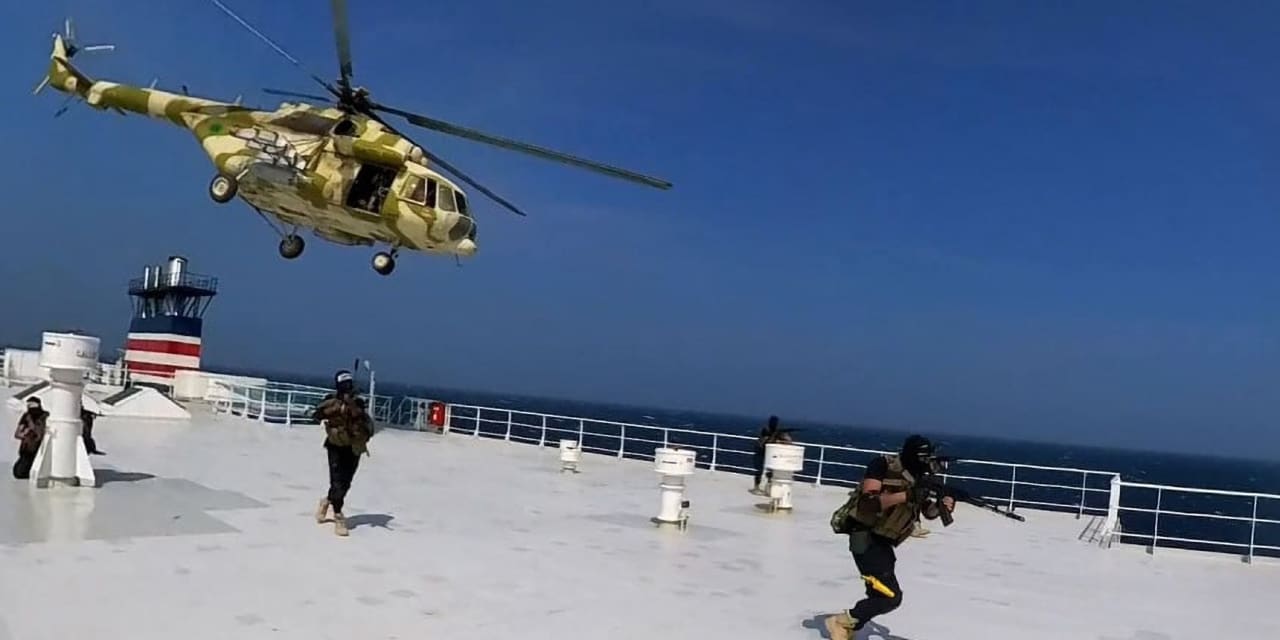When Houthi rebels hijacked an Israeli-linked cargo ship in November and took the crew hostage, they provided a stark reminder that piracy isn’t confined to history books and Hollywood movies.
As old as seafaring itself, piracy can thrive anywhere the rule of law breaks down—as in war-torn Yemen—and where shipping lanes are vulnerable. Attack drones are a modern twist, but Houthi tactics are age-old.
America’s heavy-handed response is an ancient one, too. While pirates are portrayed as lovable rogues in pop culture, real ones threaten the wealth, well-being, and stability of civilized states. They deserve no mercy.
“Piracy was the first universal crime,” Douglas B. Stevenson, former director for the Center of Seafarers’ Rights at the Seaman’s Church Institute, tells Barron’s. “Because it was considered a particularly heinous crime, pirates were deemed to be hostis humani generis, or enemies of all humanity.”
Piracy remains a universal crime, meaning any country can prosecute a pirate for any infraction committed anywhere. And modern waters are better patrolled than ever.
Yet piracy persists, finding new havens, willing crews, and outside backing while “using whatever the weapons of the time,” Stevenson says, from cutlasses to missiles.
The Houthis are Iran-backed, Shiite militants engaged in a protracted civil war with Yemen’s government, which they claim is a puppet for Saudi Arabia and the U.S. The nation is in chaos, gripped by a humanitarian crisis, and both sides have been accused of war crimes.
Houthi leadership said the hijacking of the Bahamas-flagged Galaxy Leader and other Red Sea attacks were responses to Israeli actions in Gaza against Hamas, another Iran client. U.S. and allied warships have traded missile fire with the Houthis since Jan. 12, and both sides have vowed to fight on. The attacks have disrupted commerce and pushed up shipping rates.
Perhaps the most famous victim of piracy was Julius Caesar, captured in 75 B.C.E by Cilician pirates then terrorizing the Mediterranean. They demanded a ransom of 20 talents (about $5 million).
“He laughed at them,” Plutarch writes, insisting he was worth 50 talents.
As it was collected, Caesar spent a month drinking and dicing with these cutthroats. He even “laughingly threatened to hang them all” when he was free. Ha, ha!
Once the 50 talents were delivered and Caesar was released, he tracked down the pirates and had them all crucified.
A few years later, Rome sent Pompey the Great, with a force of 500 ships and 120,000 men, to subdue the pirates for good. The Mediterranean truly became Mare Nostrum—“our sea,” as the Romans called it—and the stage was set for empire.
The U.S., too, would learn the benefits of sea power. But first it needed a navy.
After the Revolutionary War, American shipping was targeted by British, French, and Ottoman pirates and privateers. This was dearly felt on Wall Street, which financed much of the nation’s overseas commerce (including the slave trade).
When the U.S. Navy was commissioned in 1794—six frigates costing $688,888.82 (about $21 million today)—Wall Street was there. The Bank of New York lent $200,000 to the U.S.
Piracy remained a problem. North Africa’s Barbary Coast had been a haven for pirates for centuries. Vessels and goods were confiscated; people were sold into slavery.
European nations paid tribute to minimize attacks, as did the U.S., starting in 1795. But in 1801, President Thomas Jefferson received one demand too many.
“Our commerce in the Mediterranean was blockaded; and that of the Atlantic in peril,” Jefferson said in his first annual message to Congress. “The style of the demand admitted but one answer.”
Jefferson sent three frigates and a schooner, with orders to “chastise their insolence—by sinking, burning, or destroying their ships and vessels wherever you shall find them.”
Jefferson’s fleet was hardly comparable to Pompey’s, even when expanded to 11 vessels three years later. But it was enough to storm “the shores of Tripoli,” as “The Marines’ Hymn” goes, and plant the American flag on foreign soil for the first time.
A peace treaty, requiring no tribute, was signed. The benefits of sea power had been demonstrated.
From 1815 to 1822, it was pirates of the Caribbean—including the Lafitte brothers, Jean and Pierre—who needed putting down. In the 1840s and ‘50s, the U.S. Navy helped the British Royal Navy police the China Sea.
Even as the Age of Sail gave way to steam- and even nuclear-powered ships, pirates found ways and places to flourish.
William Langewiesche, who chronicles modern piracy in The Outlaw Sea: A World of Freedom, Chaos, and Crime, describes two dangerous 21st-century developments, “the first being a modern and sophisticated strain of piracy, and the second its politicized cousin, the maritime form of the new stateless terrorism.”
Both were evident in the piracy that engulfed the Horn of Africa amid Somalia’s collapse in the 2000s. Hundreds of vessels were taken and their crews held for ransom.
The bungled hijacking of the U.S.-flagged Maersk Alabama by four AK-47-wielding teens drew the media spotlight in April 2009. Captain Richard Phillips was eventually rescued and three pirates killed by Navy sharpshooters.
More than 25 nations, including all five permanent members of the Security Council, have contributed to U.N.-sanctioned patrols off Somalia. Piracy there has all but ceased.
Now, Houthi pirates are in the spotlight. That the militants are part of a much larger Middle East conflict will only make the task of defeating them more difficult. And they won’t be the last pirates.
“At a time when every last patch of land is claimed by one government or another,” Langewiesche writes, the sea “is a place that remains radically free.”
Write to [email protected]
Read the full article here




